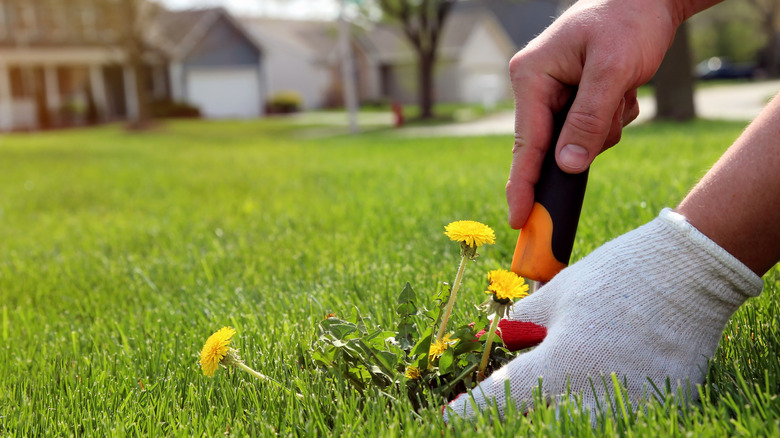The Essential Tool That Can Help Get Rid Of Stubborn Dandelions
We may receive a commission on purchases made from links.
Dandelions (Taraxacum officinale) can quickly take over a yard and suffocate grass, so it's understandable that you'd want to remove these ubiquitous weeds. However, when trying to pull these weeds up by hand you might notice that it's not as easy as it looks. This is because dandelions feature a taproot that can reach 6 to 18 inches deep into the soil — meaning they can hold on for dear life when you try to remove them. The depth of this taproot means that pulling the above-ground part of a dandelion isn't enough, since they can regenerate with ease from said taproot. Instead of battling a consistent array of dandelions in your yard, you should use a specific tool to get rid of weeds in your lawn or garden: a hand weeder.
Designed exclusively for ripping out deep-rooted weeds, a hand weeder can help reduce the strain of bending down and ripping weeds out with hand strength alone. These tools make it easy to eradicate weeds from the sidewalk, yard, or garden in less time than pulling them out by hand. Hand weeders are typically the size of a trowel with various prong configurations varying by size and brand. Most hand weeders on the market, such as the Fiskars Ergo Weeder Tool, feature an ergonomic handle for a more comfortable grip. Readily available at most garden shops, as well as online, these tools can be your secret weapon in stopping dandelions from taking over your yard.
Using a hand weeder to fully remove dandelions
You may want to buy more than one kind of hand weeder, depending on your needs. One option is the Garden Guru Crack Weeder Tool, which features an L-shaped head for precise targeting of dandelions in your sidewalk cracks. Or, the Garden Guru Titanium Dandelion Weeder Tool can work best for your lawn. Start by snipping flower heads with garden shears — or else you may end up scattering seeds across your lawn. Also, weed removal works best when the ground is wet, but not soggy. In dry soil, there's a chance that roots may break off, while soggy soil can cause soil clumping.
Stick your hand weeder near the weed's roots, working it back and forth in order to loosen the soil around the dandelion and its roots. Work all the way around clockwise before driving the tool underneath the taproot. Once within your grasp, yank the root up, removing it fully. Then, toss the weed and taproot in your trash — not your compost. While composting some weeds is fine, avoid putting dandelions in your compost pile since they can grow back and spread. Remember that removing young plants is easier, so stay vigilant on removals. You can also apply a pre-emergent herbicide in the early spring to stop their germination. Dandelions grow quickly, and each plant is capable of producing 15,000 seeds, so a two-prong approach with a hand tool, and preventive measures, can be the key to stopping their spread.

